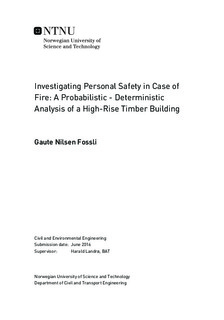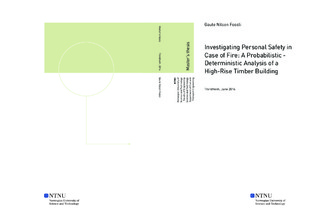| dc.description.abstract | After performance based building codes was introduced in Norway, documenting sufficient fire safety in buildings has proved difficult. In order to document sufficient fire safety, this thesis suggests probabilistic fire safety design, which means quantifying risk due to fire. Risk is a product of probabilities and consequences, meaning that probabilities of events and associated consequences must be identified. The probabilistic method chosen in this thesis is event tree analysis, which will be utilised to quantify personal risk due to fire.
An event tree is a logical description that describes the chronology of a fire. Events are typically related to fire protection systems such as sprinklers. Often the events are discrete, meaning that they represent systems functioning or failing. Probabilities of events are decided from statistical data, whereas consequences are decided by using well-known deterministic tools. By following different paths from the initiating event to the end of the event tree, different risks are calculated and total risk can be found.
Risk will be quantified for a timber construction, as they are becoming increasingly popular in the building industry. Products such as Cross Laminated Timber and Glue Laminated Timber allow tall timber buildings. Due to its aesthetic characteristics, it is desired that timber is visible in buildings, leading to large surface areas of unprotected timber. As timber is a combustible material and produces more smoke than allowed, a deviation from the Norwegian regulations and guidelines is caused. The deviation means that fire safety engineers must document that designs using timber are at least as safe as the solution presented by the guidelines. Documenting fire safety for timber constructions have proven to be even more challenging than documenting fire safety in buildings of incombustible materials.
Due to difficulties of documenting fire safety in timber buildings, the event tree analysis is performed at an 8-floor timber building (trial design), as well as a similar concrete building (reference building), which is an acceptance criterion. The risk levels are then compared to assess whether the safety of the trial design is sufficient or not. By comparing the results, both analyses are subject to the same uncertainties, eliminating uncertainty due to input parameters into the analysis, which is a major critique of the method.
The risk was successfully quantified in both the trial design and in the reference building. Since the risk in the trial design was approximately twice as high as the risk in the reference building, safety due to fire is too low. However, by implementing a structural measure, the risk level was reduced beneath the risk level of the reference building. Although the performed analysis is not complete, it shows promise regarding documentation of fire safety. Furthermore, several improvements have been suggested to deal with uncertain input parameters and long analysis time, which are two major critiques against probabilistic design. Moreover, the thesis showcases the opportunities of risk-based thinking, such as increased flexibility. Now the author calls upon the authorities to decide upon a quantified overall risk acceptance criterion. By doing so, fire safety engineers can create more value for all stakeholders, due to reduced computational resources. | |

